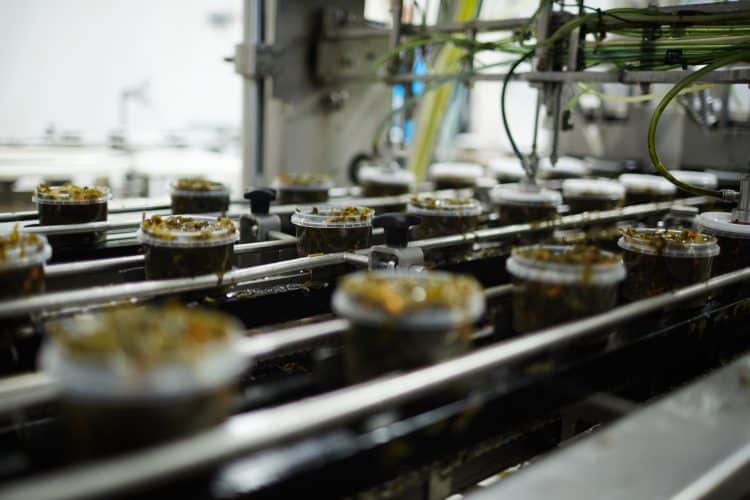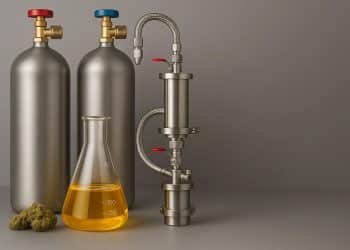The Ford Model T owes its success to the power of the assembly line. Mass production meant products were manufactured faster, cheaper, and in larger amounts, but it did come with one major downside. As popular as the car was, Model T’s were nearly identical to each other. When asked about the color, Ford said the cars came in, “Any color the customers want, as long as it’s black.” [1] Limiting consumer choices meant Ford could increase his output dramatically. If all the cars were black, factory workers didn’t have to think about attaching the right body to the right frame, and could just repeat their jobs endlessly. At the time, this was perfectly acceptable, but today, speed isn’t enough. Consumer demands have increased over the last century, evolving into the new era of manufacturing, today known as industry 4.0. [2] This period focuses on customization, which is common in industries like retail and finance, but it is making its way to the botanical extract industry as well. By applying these Industry 4.0 strategies, extraction businesses can adjust their strategies in this growing market.
What is Mass Customization
Henry Ford, while a significant figure in American manufacturing, is only a single link in a long chain. Ford’s system was only possible due to Eli Whitney. [3] Though he is most famous for inventing the cotton gin, Whitney’s most significant contribution to American industry is the invention of interchangeable parts. Originally developed as a way for Americans to build their own guns at home, Interchangeable parts proved to be too useful of an idea, and it quickly spread to other items as well. Being able to switch out broken parts meant those parts to be sourced and swapped from similar machines.
This resulted in the mass appeal of standardized equipment, as interchangeable parts made repairs and maintenance much simpler. After a century, Ford took this idea one step further by developing the assembly line. [4] Ford’s goal was to improve efficiency through standardization. With interchangeable parts, constant labor supply, and simplified assignments, Ford reconfigured factory systems to maximize production output. These changes were revolutionary, but ideas often improve with time.
Factories require a lot of overhead, especially when the manufacturing system relies on a surplus of parts for future projects. This led to bloated balance sheets, which prompted the creation of Just-In-Time (JIT) manufacturing.[5] What set this style apart from the previous mass production strategy was that part production was driven by demand, meaning the manufacturers didn’t make the parts until just before they assembled the car. This lowered their costs by only making the parts they needed, while simultaneously limiting storage costs for equipment over the long term.
These changes were possible due to increased technology that allowed for faster production times. With these faster speeds came the added benefit of allowing customers to have more control over designing their perfect products. If the parts weren’t made until customers ordered them, then the customers could decide which parts best satisfied their needs.
With technology only increasing since the 1970s, additional tools like AI, data analytics, the Internet of Things, and manufacturing tools like 3D printing manufacturing have prompted a new era in manufacturing characterized by mass customization. [6] Though it may have started with consumer goods like cars, customized experiences and products are more common across multiple industries.
This is true for the botanical extraction industry where a large desire for customization has developed a decentralized sector for manufacturing and services. In this new market, companies can balance the diversity of their offerings with the specialization of services. Complex offerings can attract more clientele, but specialization may attract a wider base who require the same service. Each strategy has pros and cons, and it is up to each company to decide how to find the right balance for themselves. When considering this, there are four ways that companies within the extraction industry can improve their customization.
Cosmetic Customization
The most obvious form of customization comes in the form of branding. Cosmetic customization involves generating emotional responses through products, styles, or brands to distinguish one product from a competitor’s. [7] This is especially important in the extraction industry because so many extracts are indistinguishable in appearance from rival company products. Companies looking to expand their cosmetic customization may consider evaluating their packaging, logos, or even color theory. [8]
Powerful branding should help to make a product identifiable, but that is not all. When done correctly, branding not only establishes a product’s identity, it also provides consumers with necessary information about the extract. This may include nutritional facts, side effects, extraction techniques and anything else that may confirm to consumers they are buying a quality product.
Depending on what these companies require for their customization needs, they may consider hiring consultants who specialize in marketing, advertising, or design. It’s up to each business to decide for themselves, but as the extraction industry continues to expand, branding firms may prove to be some of the most scalable businesses. With new companies constantly looking to design new promotional material for products, firms can grow at a rapid rate to meet demand. Powerful brands can help companies establish themselves in the long term, so an advertising budget may be worth the initial investment for a growing extraction company.
Transparent Customization
The second form of customizable manufacturing relates more to consumers than to business services directly. Transparent customization is the act of tailoring products to suit individual clients’ needs. [9] What sets this apart from cosmetic customization is that cosmetics focus on customizing the packaging, whereas transparent customization focuses on unique products within similar packaging. This may sound confusing, but most companies balance the degree of customizable products with the appeal each product may have for a mass audience.
A food manufacturer, for example, will ultimately sell more extracts if they diversify into more plant materials to produce extracts. They may sell various products under the same name, but each product may cover a wide area of market demand. This is an effective way to increase sales, as increased product offerings mean more opportunities for customers to buy. This strategy relies on brand loyalty, but it also encourages shoppers to come back either to try a new offering or to see what is new.
In contrast, other companies may choose customization through one material, but offer it in a variety of forms. Take honey as an example. A honey producer may elect to sell his products for food or cosmetics, with less preference on the specific product. This changes the business model slightly, encouraging a focus onto quality honey, and less of an emphasis on the variety of products. Both provide customization, but in two very different ways. The balance being struck here is up to each company to determine.
Each model may be fruitful, but different approaches may appeal to different business structures. By evaluating which strategy works best, companies may also find ways to better establish their brands. This could manifest in the form of reputational growth either from related products or from quality ingredients.
Collaborative Customization
Instead of focusing on customizing the product or the branding, it is also possible for companies within the botanical extraction industry to customize the services they offer. Take, for example, a lab testing facility. Any product that is intended for human use or consumption has to undergo regulatory approval before it goes to market. Regulatory necessities will vary by product, and may have different requirements depending on the extract.
To make sure that products meet market compliance, many firms choose to contract specialists who go through all the steps from safety tests, branding accuracy, to local regulatory approval. These kinds of companies are examples of collaborative customization within the botanical extraction industry. [10]
This concept is most easily understood by imagining a pizza restaurant. When ordering a pizza, customers can pick their own toppings, but the pizzas themselves are basically the same. In the extraction industry, any company that can provide a repeatable service, but with minor alterations to fill clients’ needs, satisfies that model and a laboratory testing facility is a great example of this. Variables like intended use, materials included, and extraction techniques may all need to be evaluated before a product is approved.
Laboratories can also balance their testing flexibility with product specialization, depending on what demand in their local market looks like. The balance will most likely vary from one lab to another, but using this model can help many others to carve a niche for themselves in industry 4.0.
Adaptive Customization
Adaptive customization is similar in nature to collaborative customization, but with one key difference. [11] Both of them rely on customization of services, but with dramatically different approaches. Collaborative customization is like choosing the toppings on a pizza, meaning companies provide the same basic service with minor differences based on customer needs. In contrast, companies that practice adaptive customization are more akin to Swiss army knives. This is to say that these firms are more like one-stop shops that provide a wide variety of services depending on what their clients may need. If lab testing facilities serve as an example for collaborative customization, a common example of adaptive customization within the world of botanical extracts would be extraction facilities themselves.
Some large manufacturers have their extraction units in house, but there are several smaller firms that prefer to outsource this job to lower their own cost basis. As a result, extraction facilities have to customize their services based on extraction techniques, solvents used, production times, sourced materials, and product potency. Thanks to adaptive customization, the way these facilities set themselves apart from their competition is by offering customized services.
This may mean synthesis of more materials, diversifying into lab testing, or through processing and storing hazardous materials. With each of these examples, other companies may find it is just as profitable to narrow their focus into a specialized area of coverage as well. Adaptive customization, more than any other customization model, also shows how this customization benefits customers. With increased options in the customization manufacturing industry, consumers get to decide how unique their experiences are. That being said, highly customized or specialized products can increase cost, so any priced sensitive client should consider a more standardized model as a result
References:
- Crowther, Samuel, and Henry Ford. My life and work. Doubleday, Page, 1922.
- Sony, Michael, and Subhash Naik. “Key ingredients for evaluating Industry 4.0 readiness for organizations: a literature review.” Benchmarking: An International Journal 27.7 (2020): 2213-2232.
- Woodbury, Robert S. “The legend of Eli Whitney and interchangeable parts.” Technology and Culture 1.3 (1960): 235-253.
- Brinkley, Douglas, and D. Brinkley. Wheels for the world: Henry Ford, his company, and a century of progress, 1903-2003. New York: Viking, 2003.
- Singh, Gurinder, and Inderpreet Singh Ahuja. “Just-in-time manufacturing: literature review and directions.” International Journal of Business Continuity and Risk Management 3.1 (2012): 57-98.
- Tseng, Mitchell M., and Jianxin Jiao. “Mass customization.” Handbook of industrial engineering 3 (2001): 684-709.
- Marathe, Sampada Sameer. “The ‘me’revolution in mediated communication: Investigating the psychology of cosmetic and functional customization.” (2010).
- Harris, Michael J. Color theory and its applications in marketing as it relates to color psychology. Diss. Ball State University, 2018.
- Schnabel, Tobias, et al. “The impact of more transparent interfaces on behavior in personalized recommendation.” Proceedings of the 43rd international ACM SIGIR conference on research and development in information retrieval. 2020.
- Palmer, Catherine, Char Booth, and Lia Friedman. “Collaborative customization: Tutorial design across institutional lines.” College & Research Libraries News 73.5 (2012): 243-248.
- Kiangala, Sonia Kahiomba, and Zenghui Wang. “An effective adaptive customization framework for small manufacturing plants using extreme gradient boosting-XGBoost and random forest ensemble learning algorithms in an Industry 4.0 environment.” Machine Learning with Applications 4 (2021): 100024.












